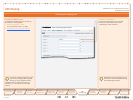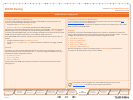
D 14049.01
07.2007
87
TANDBERG VIDEO COMMUNICATION SERVER
ADMINISTRATOR GUIDE
Text goes here
Introduction
Getting
Started
System
Overview
System
Configuration
H.323 & SIP
Configuration
Registration
Control
Zones and
Neighbors
Call
Processing
Firewall
Traversal
Bandwidth
Control
Maintenance
Appendices
TANDBERG
ADMINISTRATOR GUIDE
TANDBERG VIDEO COMMUNICATION SERVER
ADMINISTRATOR GUIDE
Call
Processing
ENUM Dialing
About ENUM Dialing
ENUM dialing allows an endpoint to be contacted by a caller
dialing an E.164 number - a telephone number - even if that
endpoint has registered using a different format of alias.
The E.164 number is converted into a URI by the DNS system,
and the rules for URI dialing are then followed to place the call.
The ENUM dialing facility allows you to retain the flexibility of
URI dialing whilst having the simplicity of being called using
just a number - particularly important if any of your callers are
restricted to dialing via a numeric keypad.
Enabling ENUM Dialing
ENUM dialing is enabled separately for incoming and outgoing
calls.
Outgoing Calls
To allow locally registered endpoints to dial out to other
endpoints using ENUM, you must
configure at least one ENUM zone, and
configure at least one DNS Server.
This is described in the section Configuring ENUM Dialing for
outgoing calls.
Incoming Calls
To enable endpoints in your enterprise to receive incoming calls
from other endpoints via ENUM dialing, you must configure a
DNS NAPTR record mapping your endpoints’ E.164 numbers
to their SIP/H.323 URIs. See the section Configuring ENUM
dialing for incoming calls for instructions on how to do this.
•
•
ENUM Dialing Overview
The VCS supports outward ENUM dialing by allowing you
to configure ENUM zones on the VCS. When an ENUM
zone is queried, this triggers the VCS to transform the
E.164 number that was dialed into an ENUM domain which is
then queried via DNS.
Note however that ENUM dialing relies on the presence of
relevant DNS NAPTR records for the ENUM domain being
queried. These are the responsibility of the administrator of
that domain.
ENUM Process
When a system is attempting dial a destination endpoint using
ENUM, the general process is as follows:
The user dials the E.164 number from their endpoint.
The system converts the E.164 number into an ENUM
domain as follows:
the digits are reversed and separated by a dot
the name of the domain that is hosting the NAPTR
records for that E.164 number is added as a suffix.
DNS is then queried for the resulting ENUM domain.
If a NAPTR record exists for that ENUM domain, this will
advise how the number should be converted into one (or
possibly more) H.323/SIP URIs.
The system then sends out another DNS query for that URI.
From this point the process for URI Dialing is followed.
1.
2.
a.
b.
3.
4.
5.
If an ENUM zone and/or a DNS server have not been
configured on the local VCS, calls made using ENUM
dialing could still be placed if the local VCS is
neighbored with another VCS that has been appropriately
configured. Any ENUM dialed calls will go via the neighbor. This
configuration is useful if you want all ENUM dialing from your
enterprise to be configured on one particular system.


















